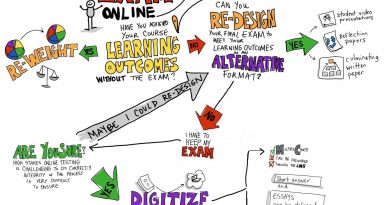Part II: Asynchronous vs. Synchronous Instruction for different Instructional Formats
By Heather Dwyer, CELT
An online course combines a variety of learning experiences that may contain both synchronous (live, i.e., real-time) instruction and asynchronous (on your own) instruction. Just as in a face-to-face course, these learning experiences look different depending on the type of class. Common instructional formats include lecture, discussion, lab, and studio classes. Understandably, not all courses fit perfectly into these four categories, and many include some combination. Your course may also have goals around experiential learning, global learning, civic engagement, or clinical practice, which further impact the student learning experience.
The following sections may help you think about instructional methods to help students develop the knowledge and skills they’ll need to be successful on assessments. You can start by considering your current approach to content delivery and learning experiences, and how those translate to an online environment. As you do so, remember that it’s also important to regularly refer to learning objectives and assessments to confirm that they align properly with your instructional methods.
Lecture
Purpose
The primary purpose of lecture is for the instructor to deliver content to students. Lectures involve varying levels of interactivity. Students are usually responsible for taking notes during lecture and participating in any in-lecture activities (e.g., polling questions). Because of its efficiency, the lecture format is more common in larger courses.
| Traditional face-to-face method | Asynchronous options | Synchronous options |
| Instructor lectures on topic during scheduled class period | Pre-recorded lectures, usually narrated slideshow or whiteboard-style (created or curated) Readings (articles, textbook, instructor-created written content) Other existing media (videos, podcasts, etc) | Live lecture sessions over zoom or other video conferencing platform during scheduled class period. These platforms have capabilities to make lecture more interactive, including participant non-verbal cues, polling, and annotations of whiteboards. |
Recommended Practice
For a more equitable and engaging approach, short, pre-recorded lectures and other asynchronous modes as the main method of content delivery are preferable to longer synchronous lectures. This is because some students may experience constraints on their schedules, learning spaces, and access to reliable internet when learning from home, and as a result might have difficulty accessing the synchronous lecture during the scheduled class period. Moreover, from a learner perspective, the experience of watching a long (>30 min) lecture over live video conference is quite different from attending a similarly long lecture in person – the lack of non-verbal cues and fellow students, combined with the distractions at home make for a more arduous learning experience. Shorter pre-recorded lectures break content into digestible chunks and allow students to access the content at their own pace. It is recommended to save synchronous sessions for more heavily interactive aspects of class.
Additional Relevant Resources
Discussion
Purpose
Discussions usually involve smaller groups of students and a heavy component of interactivity. Discussions can be used for unpacking complex concepts, small group work, case studies, problem-solving, and more. Discussions can also be an important contributor to maintaining connection among students and helping the class feel like a learning community.
| Traditional face-to-face method | Asynchronous options | Synchronous options |
| Instructor facilitates discussion among students during scheduled class time. Discussion may take a number of formats (e.g., roundtable conversation among the entire class, small group work, debate, role play/simulation, etc.). | Virtual discussion board (e.g., Canvas discussion board) Collaborative media spaces (e.g., Voice Thread) Student-selected media for small group interactions (e.g., texting, phone calls, Slack, Signal , WhatsApp, etc.). | Live interactive sessions over Zoom or other video conferencing platform during scheduled class period. These platforms have many capabilities to support specific approaches to discussion, including breakout rooms, virtual whiteboards, polling, image annotation, and more. |
Recommended Practice
Whether conducting discussion synchronously or asynchronously, try to build in structured opportunities for students to connect with each other and with you. The online learning environment can feel isolating to students. Discussion is inherently interactive, but it may take time for students to feel they can naturally engage with one another in an online learning space. Make sure your expectations for participation are clearly communicated and structured. For example, in an asynchronous discussion board, ask students to respond to specific prompts and to one another, with clear deadlines and points allocated to incentivize participation. In a synchronous discussion, leverage the capabilities of the video conferencing platform (e.g., Zoom) to ensure that as many students as possible are participating. The whiteboard function is a helpful way to elicit anonymous participation; students may also feel “safer” contributing to the conversation via the chat function or in breakout rooms.
Additional Relevant Resources
- Engaging Students and Eliciting Interaction While Teaching Remotely
- Ways to Engage Students When Teaching Remotely with Zoom
- The Art and Science of Successful Online Discussions (Faculty Focus)
Laboratory
Purpose
Labs, usually associated with STEM courses and some social science courses, involve hands-on application of course concepts. Students might carry out experiments, write computer programs, or collect observational data to produce a deliverable (e.g., a lab report). Labs can be difficult to translate to an online environment since students won’t have access to the lab spaces and materials they normally would in a face-to-face environment.
| Traditional face-to-face method | Asynchronous options | Synchronous options |
| Instructor or TA guides students through a | Pre-recorded videos of a lab experiment being executed Laboratory simulations moderated via software At home experiments conducted by individual students | Live demonstrations of lab experiments over video conference Students work in small groups to design experiments or analyze data provided On campus equipment, controlled by remote students (may require set up from on campus personnel & internet enabled controls). |
Recommended Practice :
- Before choosing a method for replacing lab in an online learning environment, define for yourself what the lab is meant to achieve. Clarifying the goal of the lab can help you decide which option, whether asynchronous or synchronous, will be most appropriate for your students’ learning. For example, if the focus is on learning lab techniques, you can have students engage in online simulations. If the focus is on analyzing experimental data, you can provide students with sample data sets from experiments similar to those students would have seen in the lab and have students conduct an analysis as though they collected the data themselves. (Adapted from Dartmouth University’s “Remote Lab Activities and Experiences”)
Additional Relevant Resources
- There are many online resources for lab simulations and experiments. We have compiled some of these resources on a Google doc.
- Dartmouth University’s “Remote Lab Activities and Experiences“
Studio
Purpose
Studio courses, typically associated with art, design, theater, and music, involve students practicing and creating work. Students may have been exposed to knowledge and skills didactically before being asked to apply the knowledge and skills creatively. Studios often involve self-directed learning. Studios can be difficult to translate to an online learning environment because they usually occur in extended time blocks with immediate, individualized feedback from the instructor.
| Traditional face-to-face method | Asynchronous options | Synchronous options |
| Students work on creative assignments during scheduled class time (and sometimes out of it). Instructor may provide lectures or demonstrations throughout the course. Often, assignments culminate in a critique, which occurs during scheduled class time. | Pre-recorded lecture videos Students work on their projects at home, at their own pace Critique via discussion board or other technology tool (e.g., Canvas ePortfolio; Padlet) Recorded audio or written feedback to students | Live demonstrations or short lectures over video conference Small group work via video conference Critique via video conference |
Recommended Practice
It is difficult to achieve the spontaneous feedback and one-on-one instruction that often occurs in a face-to-face format, so it’s worth considering alternatives to achieving that level of intimacy and immediacy. You can set aside times to meet with students over your video conferencing platform and, if appropriate, leverage the annotation tool on a digital image of their work as you meet. If meeting synchronously isn’t possible, you can make an audio recording in which you deliver feedback verbally – even though the student isn’t in front of you to receive it. Your recorded voice can provide more of a personal connection than written feedback. Consider having students submit a short reflective piece to accompany final work, which can specify their intention or add context that a student might normally communicate in person.
Additional Relevant Resources
- We have compiled resources relevant to teaching the arts on this Google Doc
- Remotely Hands-On: Teaching lab sciences and fine arts during COVID-19
SEE ALSO
Part I: Asynchronous vs. Synchronous Instruction
Image credit: Medford/Somerville, Mass. – Small groups of students enjoy the evening on the President’s Lawn (Alonso Nichols/Tufts University)



